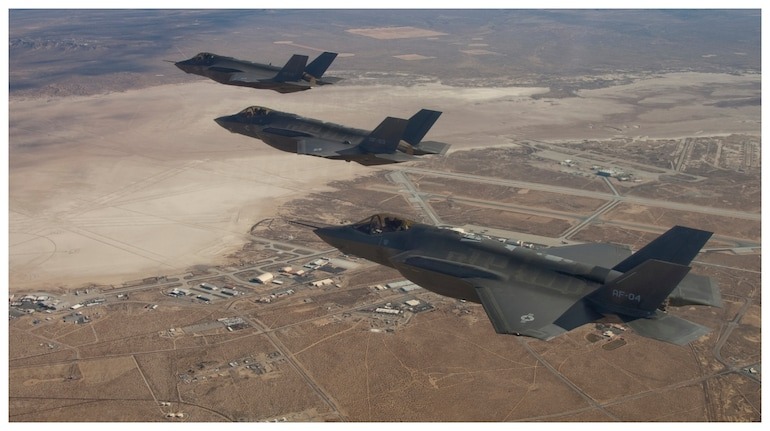
In recent months, NATO countries and Canada have been rethinking their decisions to purchase advanced US defense technology, particularly the F-35 Joint Strike Fighter. The shifting stance of the Trump administration has led many to question whether continued investment in US-made weapons is a wise strategic move. As the global political landscape evolves, countries are considering alternatives, including European-made aircraft, in place of the costly F-35 and other US jets.
US Foreign Policy Under Trump Raises Concerns Among Allies
In less than two months, President Donald Trump has significantly altered US foreign policy, leading to growing uncertainty among NATO members. The US president's actions, including repeated overtures to Russia and suspending foreign aid, have left NATO countries questioning whether the US will uphold its commitment to defend them in the event of an attack, particularly by Russia.
As tensions rise in Europe, Pete Hegseth, Trump's defense secretary, further exacerbated concerns by stating that the US may no longer be primarily focused on the security of Europe. This stance is shaking the confidence of many European nations that have historically relied on the US for defense support.
F-35 Sales Impacted by European Shifts in Defense Strategy
The F-35, produced by Lockheed Martin, is one of the most advanced and expensive military aircraft in the world. Designed to combine stealth, maneuverability, and attack capabilities, each jet costs approximately $85 million, with prices rising when factoring in infrastructure and spare parts. Yet, as the war in Ukraine continues, and with Eastern European NATO members still relying on Soviet-era weaponry, many countries are rethinking their defense strategies.
The F-35 program, which initially saw global support, may now face growing resistance. European NATO countries, such as Canada and Portugal, are exploring alternatives, including European-made jets like the Saab Gripen, Eurofighter Typhoon, and Dassault Rafale.
Canada and Portugal Question F-35 Purchases
In Canada, where Trump's trade policies have led to tensions, Prime Minister Mark Carney has asked Defense Minister Bill Blair to review Canada's ongoing purchase of F-35s. With Canada already involved in the development of the F-35, the country’s defense officials are questioning whether this choice remains appropriate given the changing political climate and relationship with the US.
In Portugal, the outgoing defense minister echoed similar concerns, stating that recent US actions had made it necessary to reconsider the purchase of the F-35. The growing unpredictability of US policies, he noted, has led to discussions about alternative options for replacing Portugal’s aging F-16 fleet.
The F-35: Costly, Powerful, and Controversial
Despite its advanced capabilities, the F-35 has faced mounting criticism due to its high costs. The aircraft, particularly the F-35B variant, which can take off vertically from ship decks, is the most expensive weapons system ever produced by the US. Its lifetime costs are projected to exceed $1.7 trillion, with sales to international customers playing a significant role in offsetting these expenses.
However, concerns about US control over military technology have also emerged. The F-35’s reliance on constant updates from the US raises fears that, should a relationship sour, a country’s fleet of jets could be rendered inoperable. Winslow T. Wheeler, a defense expert, warned that while there is no "kill switch" in the F-35, delays in essential updates could jeopardize the operational readiness of the aircraft.
European Alternatives Gaining Traction
In light of these concerns, European alternatives are gaining attention. The Saab Gripen, Eurofighter Typhoon, and Dassault Rafale are being considered as replacements for the F-35. Though these jets lack the stealth capabilities of the F-35, they are seen as more cost-effective options for countries concerned about both affordability and dependence on US technology.
- The Saab Gripen is significantly cheaper and is used by several countries, including Brazil, Thailand, and Hungary.
- The Eurofighter Typhoon, a versatile fighter jet, is used by the UK, Germany, and other European nations.
- The Dassault Rafale, used by France and several other countries, offers advanced capabilities and has garnered significant export interest.
The Path Forward: European Defense Independence?
Some experts, like David Jordan, a senior lecturer at King’s College London, argue that Europe is capable of building its own defense systems within the next 5 to 10 years. As European nations look to reduce their dependence on US defense technology, there is potential for a more cohesive and independent European defense strategy. French President Emmanuel Macron has already advocated for increased reliance on European contractors like Dassault for defense needs, pushing for greater investment in domestic production.
Read More: World Bank Approves 700 Million Dollars for Pakistan to Boost Economic Stability and Public Services

 Share
Share



